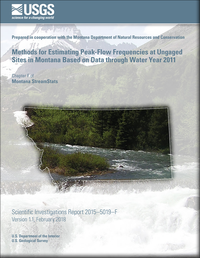Methods for estimating peak-flow frequencies at ungaged sites in Montana based on data through water year 2011: Chapter F in Montana StreamStats
Links
- Document: Report (7.95 MB pdf)
- Larger Work: This publication is Chapter F of Montana StreamStats
- Appendix: Tables 1–1 through 1–5 (250 kB xlsx)
- Version History: Version History (6.13 kB txt)
- Download citation as: RIS | Dublin Core
Abstract
The U.S. Geological Survey (USGS), in cooperation with the Montana Department of Natural Resources and Conservation, completed a study to update methods for estimating peak-flow frequencies at ungaged sites in Montana based on peak-flow data at streamflow-gaging stations through water year 2011. The methods allow estimation of peak-flow frequencies (that is, peak-flow magnitudes, in cubic feet per second, associated with annual exceedance probabilities of 66.7, 50, 42.9, 20, 10, 4, 2, 1, 0.5, and 0.2 percent) at ungaged sites. The annual exceedance probabilities correspond to 1.5-, 2-, 2.33-, 5-, 10-, 25-, 50-, 100-, 200-, and 500-year recurrence intervals, respectively.
Regional regression analysis is a primary focus of Chapter F of this Scientific Investigations Report, and regression equations for estimating peak-flow frequencies at ungaged sites in eight hydrologic regions in Montana are presented. The regression equations are based on analysis of peak-flow frequencies and basin characteristics at 537 streamflow-gaging stations in or near Montana and were developed using generalized least squares regression or weighted least squares regression.
All of the data used in calculating basin characteristics that were included as explanatory variables in the regression equations were developed for and are available through the USGS StreamStats application (http://water.usgs.gov/osw/streamstats/) for Montana. StreamStats is a Web-based geographic information system application that was created by the USGS to provide users with access to an assortment of analytical tools that are useful for water-resource planning and management. The primary purpose of the Montana StreamStats application is to provide estimates of basin characteristics and streamflow characteristics for user-selected ungaged sites on Montana streams. The regional regression equations presented in this report chapter can be conveniently solved using the Montana StreamStats application.
Selected results from this study were compared with results of previous studies. For most hydrologic regions, the regression equations reported for this study had lower mean standard errors of prediction (in percent) than the previously reported regression equations for Montana. The equations presented for this study are considered to be an improvement on the previously reported equations primarily because this study (1) included 13 more years of peak-flow data; (2) included 35 more streamflow-gaging stations than previous studies; (3) used a detailed geographic information system (GIS)-based definition of the regulation status of streamflow-gaging stations, which allowed better determination of the unregulated peak-flow records that are appropriate for use in the regional regression analysis; (4) included advancements in GIS and remote-sensing technologies, which allowed more convenient calculation of basin characteristics and investigation of many more candidate basin characteristics; and (5) included advancements in computational and analytical methods, which allowed more thorough and consistent data analysis.
This report chapter also presents other methods for estimating peak-flow frequencies at ungaged sites. Two methods for estimating peak-flow frequencies at ungaged sites located on the same streams as streamflow-gaging stations are described. Additionally, envelope curves relating maximum recorded annual peak flows to contributing drainage area for each of the eight hydrologic regions in Montana are presented and compared to a national envelope curve. In addition to providing general information on characteristics of large peak flows, the regional envelope curves can be used to assess the reasonableness of peak-flow frequency estimates determined using the regression equations.
Suggested Citation
Sando, Roy, Sando, S.K., McCarthy, P.M., and Dutton, D.M., 2016, Methods for estimating peak-flow frequencies at ungaged sites in Montana based on data through water year 2011 (ver. 1.1, February 2018) : U.S. Geological Survey Scientific Investigations Report 2015–5019–F, 30 p., https://doi.org/10.3133/sir20155019F.
ISSN: 2328-0328 (online)
Study Area
Table of Contents
- Acknowledgments
- Abstract
- Introduction
- General Flood Characteristics in Montana
- Peak-Flow Frequencies at Streamflow-Gaging Stations
- Methods for Estimating Peak-Flow Frequencies at Ungaged Sites in Montana
- Examples of Estimating Peak-Flow Frequencies at Ungaged Sites
- Summary
- References Cited
- Appendix 1. Supplemental Information Relating to the Regional Regression Analysis
| Publication type | Report |
|---|---|
| Publication Subtype | USGS Numbered Series |
| Title | Methods for estimating peak-flow frequencies at ungaged sites in Montana based on data through water year 2011: Chapter F in Montana StreamStats |
| Series title | Scientific Investigations Report |
| Series number | 2015-5019 |
| Chapter | F |
| DOI | 10.3133/sir20155019F |
| Edition | Version 1.1: February 2018 |
| Publication Date | April 05, 2016 |
| Year Published | 2016 |
| Language | English |
| Publisher | U.S. Geological Survey |
| Publisher location | Reston, VA |
| Contributing office(s) | WY-MT Water Science Center |
| Description | Report: viii, 30 p.; 5 Tables |
| Larger Work Type | Report |
| Larger Work Subtype | USGS Numbered Series |
| Larger Work Title | Montana StreamStats (Scientific Investigations Report 2015-5019) |
| Country | United States |
| State | Montana |
| Online Only (Y/N) | Y |
| Additional Online Files (Y/N) | Y |


